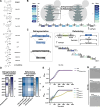Iterative SCRaMbLE for engineering synthetic genome modules and chromosomes
- PMID: 40774952
- PMCID: PMC12331891
- DOI: 10.1038/s41467-025-62356-y
Iterative SCRaMbLE for engineering synthetic genome modules and chromosomes
Abstract
Saccharomyces cerevisiae is closing-in on the first synthetic eukaryotic genome with genome-wide redesigns, including LoxPsym site insertions that enable inducible genomic rearrangements in vivo via Cre recombinase through SCRaMbLE (Synthetic Chromosome Recombination and Modification by LoxPsym-mediated Evolution). Combined with selection, SCRaMbLE quickly generates phenotype-enhanced strains by diversifying gene arrangement and content. Here, we demonstrate how iterative cycles of SCRaMbLE reorganises synthetic genome modules and chromosomes to improve functions. We introduce SCOUT (SCRaMbLE Continuous Output and Universal Tracker), a reporter system that allows sorting of SCRaMbLEd cells into high-diversity pools. Paired with long-read sequencing, SCOUT enables high-throughput mapping of genotype abundance and genotype-phenotype relationships. Iterative SCRaMbLE is applied here to yeast strains with a full synthetic chromosome and histidine biosynthesis modules. Five HIS module designs are tested, and SCRaMbLE is used to optimise the poorest performer. Our results highlight iterative SCRaMbLE as a powerful tool for data driven modular genome design.
© 2025. The Author(s).
Conflict of interest statement
Competing interests: K.C. is now an employee of Oxford Nanopore Technologies but was solely employed by Imperial College London during the time generating the data included in this paper. All other authors declare no conflicts of interest.
Figures




Similar articles
-
SCRaMbLE-in: A Fast and Efficient Method to Diversify and Improve the Yields of Heterologous Pathways in Synthetic Yeast.Methods Mol Biol. 2020;2205:305-327. doi: 10.1007/978-1-0716-0908-8_17. Methods Mol Biol. 2020. PMID: 32809206
-
SCRaMbLE: a Versatile Tool for Genome Manipulation.Physiology (Bethesda). 2025 Sep 1;40(5):0. doi: 10.1152/physiol.00049.2024. Epub 2025 Feb 12. Physiology (Bethesda). 2025. PMID: 39938087 Review.
-
Rapid pathway prototyping and engineering using in vitro and in vivo synthetic genome SCRaMbLE-in methods.Nat Commun. 2018 May 22;9(1):1936. doi: 10.1038/s41467-018-04254-0. Nat Commun. 2018. PMID: 29789543 Free PMC article.
-
L-SCRaMbLE as a tool for light-controlled Cre-mediated recombination in yeast.Nat Commun. 2018 May 22;9(1):1931. doi: 10.1038/s41467-017-02208-6. Nat Commun. 2018. PMID: 29789561 Free PMC article.
-
The Lived Experience of Autistic Adults in Employment: A Systematic Search and Synthesis.Autism Adulthood. 2024 Dec 2;6(4):495-509. doi: 10.1089/aut.2022.0114. eCollection 2024 Dec. Autism Adulthood. 2024. PMID: 40018061 Review.
References
-
- Gibson, D. G. et al. Creation of a bacterial cell controlled by a chemically synthesized genome. Science329, 52–56 (2010). - PubMed
-
- Hutchison, C. A. et al. Design and synthesis of a minimal bacterial genome. Science351, aad6253 (2016). - PubMed
-
- Zhao, Y. et al. Debugging and consolidating multiple synthetic chromosomes reveals combinatorial genetic interactions. Cell186, 5220–5236.e16 (2023). - PubMed
-
- Richardson, S. M. et al. Design of a synthetic yeast genome. Science355, 1040–1044 (2017). - PubMed
MeSH terms
Substances
Grants and funding
LinkOut - more resources
Full Text Sources
Medical

